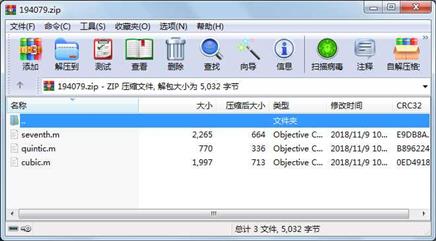资源简介
在机器人运动控制领域,轨迹规划是很关键的一步,决定了机器人运动效率,常用的轨迹规划方法是多项式插值。

代码片段和文件信息
% 三次多项式插值两点间
clear;
clc;
q0=0;q1=10;
v0=0;
v1=0;
t0=0;t1=8;
T=t1-t0;
Q=q1-q0;
a0=q0;
a1=v0;
a2=(3*Q-(2*v0+v1)*T)/power(T2);
a3=(-2*Q+(v0+v1)*T)/power(T3);
t=t0:0.01:t1;
q=a0+a1*power((t-t0)1)+a2*power((t-t0)2)+a3*power((t-t0)3);
v=a1+2*a2*power((t-t0)1)+3*a3*power((t-t0)2);
a=2*a2+6*a3*power((t-t0)1);
subplot(321);plot(tq‘r‘);ylabel(‘position‘);
grid on;
subplot(323);plot(tv‘b‘);ylabel(‘velocity‘);
grid on;
subplot(325);plot(ta‘y‘);ylabel(‘acceleration‘);
grid on;
% %三次多项式插值多个点
% clear;
% clc;
% t_array=0:2:100;
% q_array=0:10:500;
% v_array(1)=0;
% v_array(51)=0;
% t=t_array(1);
% q=q_array(1);
% v=v_array(1);
% a=[0];
% for i=1:length(t_array)-1
% %确定中间点的速度值
% if(i>1)
% di1=(q_array(i)-q_array(i-1))/(t_array(i)-t_array(i-1));
% di2=(q_array(i+1)-q_array(i))/(t_array(i+1)-t_array(i));
% if((di2>=0 && di1>=0) || (di2<=0 && di1<=0))
% v_array(i)=1.0/2.0*(di1+di2);
% else
% v_array(i)=0;
% end
% end
% end
% for i=1:length(t_array)-1
% Qi=q_array(i+1)-q_array(i);
% Ti=t_array(i+1)-t_array(i);
% a0(i)=q_array(i);
% a1(i)=v_array(i);
% a2(i)=(3*Qi-(2*v_array(i)+v_array(i+1))*Ti)/power(Ti2);
% a3(i)=(-2*Qi+(v_array(i)+v_array(i+1))*Ti)/power(Ti3);
% tau=t_array(i):Ti/100:t_array(i+1);
% qi=a0(i)+a1(i)*power((tau-tau(i))1)+a2(i)*power((tau-tau(i))2)+a3(i)*power((tau-tau(i))3);
% vi=a1(i)+2*a2(i)*power((tau-tau(i))1)+3*a3(i)*power((tau-tau(i))2);
% ai=2*a2(i)+6*a3(i)*power((tau-tau(i))1);
% t=[ttau(2:end)];q=[qqi(2:end)];v=[vvi(2:end)];a=[aai(2:end)];
% end
% subplot(311);plot(tq‘r‘);ylabel(‘position‘);
% hold on;
% %plot(t_arrayq_array‘o‘);
% grid on;
% subplot(312);plot(tv‘b‘);ylabel(‘velocity‘);
% hold on;
% %plot(t_arrayv_array‘o‘);
% grid on;
% subplot(313);plot(ta‘y‘);ylabel(‘acceleration‘);
% grid on;属性 大小 日期 时间 名称
----------- --------- ---------- ----- ----
文件 1997 2018-11-09 10:49 cubic.m
文件 770 2018-11-09 10:47 quintic.m
文件 2265 2018-11-09 10:50 seventh.m
- 上一篇:计算机操作系统课后答案
- 下一篇:共集电极放大电路Multisim仿真
 川公网安备 51152502000135号
川公网安备 51152502000135号
评论
共有 条评论